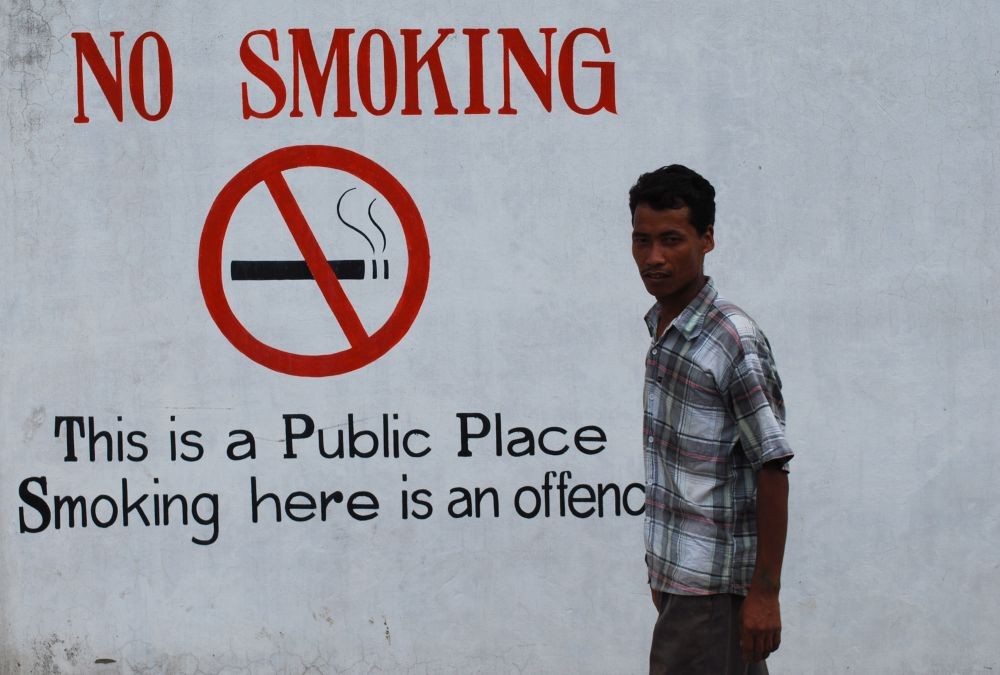A man walks by a painting prohibiting smoking inside a private hospital building in Dimapur on Saturday, May 30, 2009. World Health Organization (WHO) has selected ‘Tobacco Health Warning’ as the theme for year 2009 World No Tobacco Day. The day is observed on 31st May of every year. (Caisii Mao photo)

Atsei Neikha
Dimapur | May 30
With clear evidence available that tobacco accounts the second-largest cause of deaths in the world besides leading to innumerable health-related problems, a cross section of concerned Naga citizens have sought intensified fight against the menace. “Chewing of tobacco is injurious to health” is the statutory warning that accompanies packets of every tobacco product. In spite of this stark warning, the percentage of tobacco users in Nagaland remains undeterred.
A cause for great worry is Nagas’ tobacco consumption in recent times having virtually become a tradition with age offering no barrier. Dr Seto T Kera a Dentist, while speaking to this Reporter expressed his view that schools, churches and the larger community should play an imperatively proactive role in educating the younger lot about the “noxious stuff”.
Interestingly, when queried, a good number of youths were clueless about World No Tobacco Day, which is observed May 31 of every year. Many youths however felt that the government was not doing enough to endorse the tobacco fight. One youth commented that many youngsters today are ensnared by the lethal substance and one cannot possibly terrorize somebody to quit smoking. “That person who is a habitual user must have a bout of self-realization from within”, a concerned youth explained when told to suggest ways to bringing about changes in the behavior of tobacco users. And for that to come to by, the government has a key hand, that is to adopt consistent and effective measures.
Reverend Vilodi Sakhrie of Town Baptist Church believes that for the world to be truly effective, it will require more than some policies or suggested measures. It entails a change of heart on the part of the people themselves, he said. Another youth leader commented that the issue of tobacco should not be entertained in the church as it possibly could garner negative vibes. The depiction of smoking as an act of the “cool” culture on the big screen, is also responsible for the worsening situation of young tobacco users, he explained.
Educational institutions have also taken up collective measures to ensure that students are made attentive on the hazards of taking tobacco products. It is very important and mandatory, a primary school teacher said, to impart basic education to students on tobacco and how it jeopardizes a person’s health by causing lung and oral cancers and even affecting the mental state.
However, prohibition of smoking in public places and ban on the sale of tobacco in and around school premises has done nothing to dissuade consumption. School-going children use tobacco products such as “Pan Masala”, “Khaini”, cigarettes and “Gutkha” on a colossal scale, a source said.
The only people who seem to be basking in glory are the ones doing lucrative business in the tobacco market. Some shopkeepers have proved dependable citizens by refraining themselves from selling tobacco to children who are in school uniforms. Then there are those who do underhand business: one shopkeeper who wished to remain anonymous and spoke after much coaxing, admitted to selling “gutkhas” and cigarettes to school-going children on the sly.
Many parents especially feel that the government should be more vigorous in implementing the prohibition act. Workshops, seminars, awareness programs also ought to be conducted more often in educational institutions.
The picture of the tobacco control act in Nagaland is still very grim with many are still in the dark about the health-related problems associated with it. One common chorus of disapproval that emerged from various sections of the people in this regard was that the government is not doing enough to mobilize the masses to fight tobacco.
It may be mentioned that the theme of World No Tobacco Day for 2009 is “Tobacco Health Warnings”. This year the highlight is on pictorial warnings to be shown on packages of tobacco to make the public aware of its perilous outcome.
There have been affirmative results because of this warning. Some people actually abstained from smoking after seeing the disturbing pictures on the packets. Another focal point of world no-tobacco-day this year is to create awareness for a 100 % smoke-free environment to ensure a healthier and cleaner ambiance especially for those who are subjected to second-hand tobacco smoke.
According to the WHO, India reportedly has the highest index of oral cancer cases in the world and they attribute it to the effects of tobacco. The government of India notified revised rules on the Prohibition of smoking in public places on May 30, 2008 but it came into force from October 2, 2008. In Northeast India, Mizoram ranks the highest in tobacco consumption while Nagaland follows a close second.






